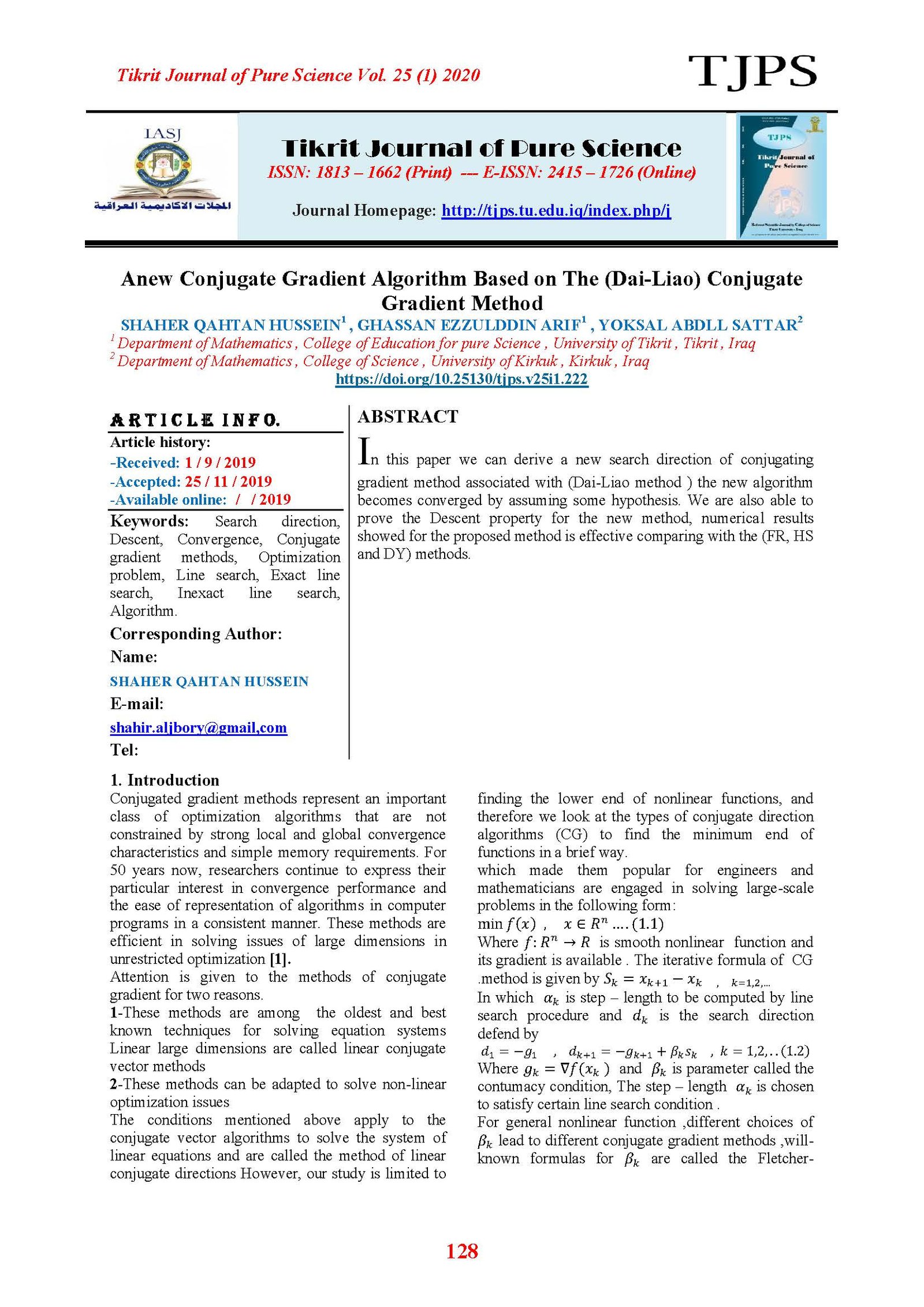Anew Conjugate Gradient Algorithm Based on The (Dai-Liao) Conjugate Gradient Method
Main Article Content
Abstract
In this paper we can derive a new search direction of conjugating gradient method associated with (Dai-Liao method ) the new algorithm becomes converged by assuming some hypothesis. We are also able to prove the Descent property for the new method, numerical results showed for the proposed method is effective comparing with the (FR, HS and DY) methods.
Article Details

This work is licensed under a Creative Commons Attribution 4.0 International License.
Tikrit Journal of Pure Science is licensed under the Creative Commons Attribution 4.0 International License, which allows users to copy, create extracts, abstracts, and new works from the article, alter and revise the article, and make commercial use of the article (including reuse and/or resale of the article by commercial entities), provided the user gives appropriate credit (with a link to the formal publication through the relevant DOI), provides a link to the license, indicates if changes were made, and the licensor is not represented as endorsing the use made of the work. The authors hold the copyright for their published work on the Tikrit J. Pure Sci. website, while Tikrit J. Pure Sci. is responsible for appreciate citation of their work, which is released under CC-BY-4.0, enabling the unrestricted use, distribution, and reproduction of an article in any medium, provided that the original work is properly cited.
References
[1] Andrei, N., (2008b), "A Hybrid Conjugate Gradient Algorithm for Unconstrained Optimization as a Convex Combination of Hestenes Stiefel and Dai-Yuan". Studies in Informatics and Control, 17 (1), 55-70.
[2] Dai, Y. H. and Liao, L. Z., (2001), "New Conjugacy Conditions and Related Nonlinear Conjugate Gradient Methods". Applied Mathematics and Optimization, Springer-Verlag, New York, USA, 43, 87-101
[3] Yabe H. and Sakaiwa, N. (2003), A New Nonlinear Conjugate Gradient Method for Unconstrained Optimization, Technical Report, Department of Mathematical Information Science, Tokyo University of Science, March,
[4] Zoutendijk, G., (1970), "Nonlinear Programming, Computational Methods". Integer and Nonlinear Programming (J. bbadie ed.). North-Holland, 37-86. [5] Sarin, R., Singh, B. K., & Rajan, S. (2014). ''Study on Approximate Gradient Projection (AGP) Property in Nonlinear Programming''. International Journal of Mathematics and Computer Applications Research (IJMCAR), 4(1), 19-30.
[6] Dai Y. H and Yuan Y, (1999). A nonlinear conjugate gradient method with a strong global convergence property, SIAM J.optimization, pp. 177-182
[7] Hestenes MR, Stiefel E (1952) Methods of conjugate gradients for solving linear systems. J Res Nat Bur Stand Sec B48:409–436..
[8] Dolan. E. D and Mor´e. J. J, "Benchmarking optimization software with performance profiles", Math. Programming, 91(2002), pp. 201-213
[9] Andrei N. (2008), "An Unconstrained Optimization test function collection". Adv. Model. Optimization. 10. pp.147-161
[10] Zhang, J., Deng, N. and Chen, L.(1999), ''New Qusi-Newton equation and related method for unconstrained optimization '',J. Optim.Theory and Appl.(102) [11] Namik, K. K. A. A. J. (2017). ''Three-terms conjugate gradient algorithm based on the Dai-Liao and the Powell symmetric methods''
[12] Lylani, YA, (2016), "Developing new three-Term Conjugate Gradient Algorithms with Applications in Multilayer Networks, pp.1-10
[13] Fletcher R. and C.M. Reeves, (1964). ''Function Minimization by Conjugate Gradients. Computer Journal'', 7, PP. 149-154
[14] Polak E. and G. Ribiére, (1969). ''Note Sur la Convergence de Directions Conjuguée. Revue Francaise Information'', Recherche.Operationnelle, (16), pp.35-43
[15] Khudhur, H M, (2015), "Numerical and Analytical study of some Descent Algorithms to solve Unconstrained Optimization, pp. 33-43
